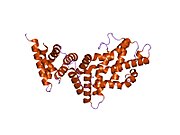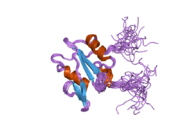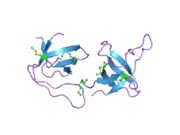Biology:RAS p21 protein activator 1
 Generic protein structure example |
RAS p21 protein activator 1 or RasGAP (Ras GTPase activating protein), also known as RASA1, is a 120-kDa cytosolic human protein that provides two principal activities:
- Inactivation of Ras from its active GTP-bound form to its inactive GDP-bound form by enhancing the endogenous GTPase activity of Ras, via its C-terminal GAP domain
- Mitogenic signal transmission towards downstream interacting partners through its N-terminal SH2-SH3-SH2 domains
The protein encoded by this gene is located in the cytoplasm and is part of the GAP1 family of GTPase-activating proteins. The gene product stimulates the GTPase activity of normal RAS p21 but not its oncogenic counterpart. Acting as a suppressor of RAS function, the protein enhances the weak intrinsic GTPase activity of RAS proteins resulting in the inactive GDP-bound form of RAS, thereby allowing control of cellular proliferation and differentiation. Mutations leading to changes in the binding sites of either protein are associated with basal cell carcinomas. Alternative splicing results in two isoforms where the shorter isoform, lacking the N-terminal hydrophobic region but retaining the same activity, appears to be abundantly expressed in placental but not adult tissues.[1]
Domains
RasGAP contains one SH3 domain and two SH2 domains, a PH domain, a C2 domain, and a GAP domain.
Interactions
RAS p21 protein activator 1 has been shown to interact with:
- ANXA6,[2]
- CAV2,[3]
- DNAJA3,[4]
- DOK1,[5][6][7]
- EPHB2,[8][9]
- EPHB3,[10]
- GNB2L1[11]
- HCK,[12]
- HRAS,[13][14][15]
- HTT,[16]
- IGF1R,[17]
- KHDRBS1,[18][19][20]
- NCK1,[21]
- PDGFRB,[22][23]
- PTK2B,[24][25]
- SOCS3,[26] and
- Src.[13][27]
The mRNA can interact with Mir-132 microRNA; this process is linked to angiogenesis.[28]
Disease database
References
- ↑ "Entrez Gene: RASA1 RAS p21 protein activator (GTPase activating protein) 1". https://www.ncbi.nlm.nih.gov/sites/entrez?Db=gene&Cmd=ShowDetailView&TermToSearch=5921.
- ↑ "Mapping the site of interaction between annexin VI and the p120GAP C2 domain". FEBS Lett. 460 (1): 166–72. October 1999. doi:10.1016/s0014-5793(99)01336-8. PMID 10571081.
- ↑ "Src-induced phosphorylation of caveolin-2 on tyrosine 19. Phospho-caveolin-2 (Tyr(P)19) is localized near focal adhesions, remains associated with lipid rafts/caveolae, but no longer forms a high molecular mass hetero-oligomer with caveolin-1". J. Biol. Chem. 277 (37): 34556–67. September 2002. doi:10.1074/jbc.M204367200. PMID 12091389.
- ↑ "A mouse homologue of the Drosophila tumor suppressor l(2)tid gene defines a novel Ras GTPase-activating protein (RasGAP)-binding protein". J. Biol. Chem. 276 (16): 13087–95. April 2001. doi:10.1074/jbc.M009267200. PMID 11116152.
- ↑ "The phosphatidylinositol polyphosphate 5-phosphatase SHIP1 associates with the dok1 phosphoprotein in bcr-Abl transformed cells". Cell. Signal. 12 (5): 317–26. May 2000. doi:10.1016/s0898-6568(00)00073-5. PMID 10822173.
- ↑ "Identification of the Abl- and rasGAP-associated 62 kDa protein as a docking protein, Dok". Cell 88 (2): 205–11. January 1997. doi:10.1016/s0092-8674(00)81841-3. PMID 9008161.
- ↑ "Evidence that Llck-mediated phosphorylation of p56dok and p62dok may play a role in CD2 signaling". J. Biol. Chem. 275 (19): 14590–7. May 2000. doi:10.1074/jbc.275.19.14590. PMID 10799545.
- ↑ "Juxtamembrane tyrosine residues couple the Eph family receptor EphB2/Nuk to specific SH2 domain proteins in neuronal cells". EMBO J. 16 (13): 3877–88. July 1997. doi:10.1093/emboj/16.13.3877. PMID 9233798.
- ↑ "Replacing two conserved tyrosines of the EphB2 receptor with glutamic acid prevents binding of SH2 domains without abrogating kinase activity and biological responses". Oncogene 19 (2): 177–87. January 2000. doi:10.1038/sj.onc.1203304. PMID 10644995.
- ↑ "Tyrosine-614, the major autophosphorylation site of the receptor tyrosine kinase HEK2, functions as multi-docking site for SH2-domain mediated interactions". Oncogene 17 (2): 255–60. July 1998. doi:10.1038/sj.onc.1201907. PMID 9674711.
- ↑ "RACK1, a protein kinase C scaffolding protein, interacts with the PH domain of p120GAP". Biochem. Biophys. Res. Commun. 283 (4): 888–95. May 2001. doi:10.1006/bbrc.2001.4889. PMID 11350068.
- ↑ "The Ras GTPase-activating protein (GAP) is an SH3 domain-binding protein and substrate for the Src-related tyrosine kinase, Hck". J. Biol. Chem. 270 (24): 14718–24. June 1995. doi:10.1074/jbc.270.24.14718. PMID 7782336.
- ↑ 13.0 13.1 "Differential actions of p60c-Src and Lck kinases on the Ras regulators p120-GAP and GDP/GTP exchange factor CDC25Mm". Eur. J. Biochem. 268 (11): 3275–83. June 2001. doi:10.1046/j.1432-1327.2001.02230.x. PMID 11389730.
- ↑ "Ras binding to a C-terminal region of GAP". FEBS Lett. 368 (2): 297–303. July 1995. doi:10.1016/0014-5793(95)00657-u. PMID 7628625.
- ↑ Sprang SR (July 1997). "GAP into the breach". Science 277 (5324): 329–30. doi:10.1126/science.277.5324.329. PMID 9518363.
- ↑ "SH3 domain-dependent association of huntingtin with epidermal growth factor receptor signaling complexes". J. Biol. Chem. 272 (13): 8121–4. March 1997. doi:10.1074/jbc.272.13.8121. PMID 9079622.
- ↑ "Localization of the insulin-like growth factor I receptor binding sites for the SH2 domain proteins p85, Syp, and GTPase activating protein". J. Biol. Chem. 270 (32): 19151–7. August 1995. doi:10.1074/jbc.270.32.19151. PMID 7642582.
- ↑ "Sam68 is a docking protein linking GAP and PI3K in insulin receptor signaling". Mol. Cell. Endocrinol. 183 (1–2): 113–21. October 2001. doi:10.1016/s0303-7207(01)00587-1. PMID 11604231.
- ↑ "Sam68 association with p120GAP in CD4+ T cells is dependent on CD4 molecule expression". J. Immunol. 161 (6): 2798–803. September 1998. doi:10.4049/jimmunol.161.6.2798. PMID 9743338.
- ↑ "Multiple SH2-mediated interactions in v-src-transformed cells". Mol. Cell. Biol. 12 (3): 1366–74. March 1992. doi:10.1128/mcb.12.3.1366. PMID 1545818.
- ↑ "Adaptor protein Nck1 interacts with p120 Ras GTPase-activating protein and regulates its activity". Cell. Signal. 23 (10): 1651–8. October 2011. doi:10.1016/j.cellsig.2011.05.019. PMID 21664272.
- ↑ "GM1 inhibits early signaling events mediated by PDGF receptor in cultured human glioma cells". Anticancer Res. 19 (6B): 5007–13. 1999. PMID 10697503.
- ↑ "SHP-2 is involved in heterodimer specific loss of phosphorylation of Tyr771 in the PDGF beta-receptor". Oncogene 21 (12): 1870–5. March 2002. doi:10.1038/sj.onc.1205210. PMID 11896619.
- ↑ "Identification of a novel protein complex containing annexin VI, Fyn, Pyk2, and the p120(GAP) C2 domain". FEBS Lett. 469 (1): 88–92. March 2000. doi:10.1016/s0014-5793(00)01252-7. PMID 10708762.
- ↑ "RAFTK/Pyk2 tyrosine kinase mediates the association of p190 RhoGAP with RasGAP and is involved in breast cancer cell invasion". Oncogene 19 (10): 1318–28. March 2000. doi:10.1038/sj.onc.1203422. PMID 10713673.
- ↑ "Tyrosine-phosphorylated SOCS-3 inhibits STAT activation but binds to p120 RasGAP and activates Ras". Nat. Cell Biol. 3 (5): 460–5. May 2001. doi:10.1038/35074525. PMID 11331873.
- ↑ "Molecular features of the viral and cellular Src kinases involved in interactions with the GTPase-activating protein". Mol. Cell. Biol. 11 (10): 5059–67. October 1991. doi:10.1128/mcb.11.10.5059. PMID 1717825.
- ↑ "MicroRNA-132–mediated loss of p120RasGAP activates the endothelium to facilitate pathological angiogenesis". Nat Med 16 (8): 909–14. 2010. doi:10.1038/nm.2186. PMID 20676106.
Further reading
- "Ras-GTPase activating protein (GAP): a putative effector for Ras". Cell. Signal. 9 (2): 153–8. 1997. doi:10.1016/S0898-6568(96)00135-0. PMID 9113414.
- "RASA1: variable phenotype with capillary and arteriovenous malformations". Curr. Opin. Genet. Dev. 15 (3): 265–9. 2005. doi:10.1016/j.gde.2005.03.004. PMID 15917201.
External links
- GeneReviews/NCBI/NIH/UW entry on Capillary Malformation-Arteriovenous Malformation Syndrome and RASA1-Related Parkes Weber Syndrome
- OMIM entries in RASA1 related disorders
 |







